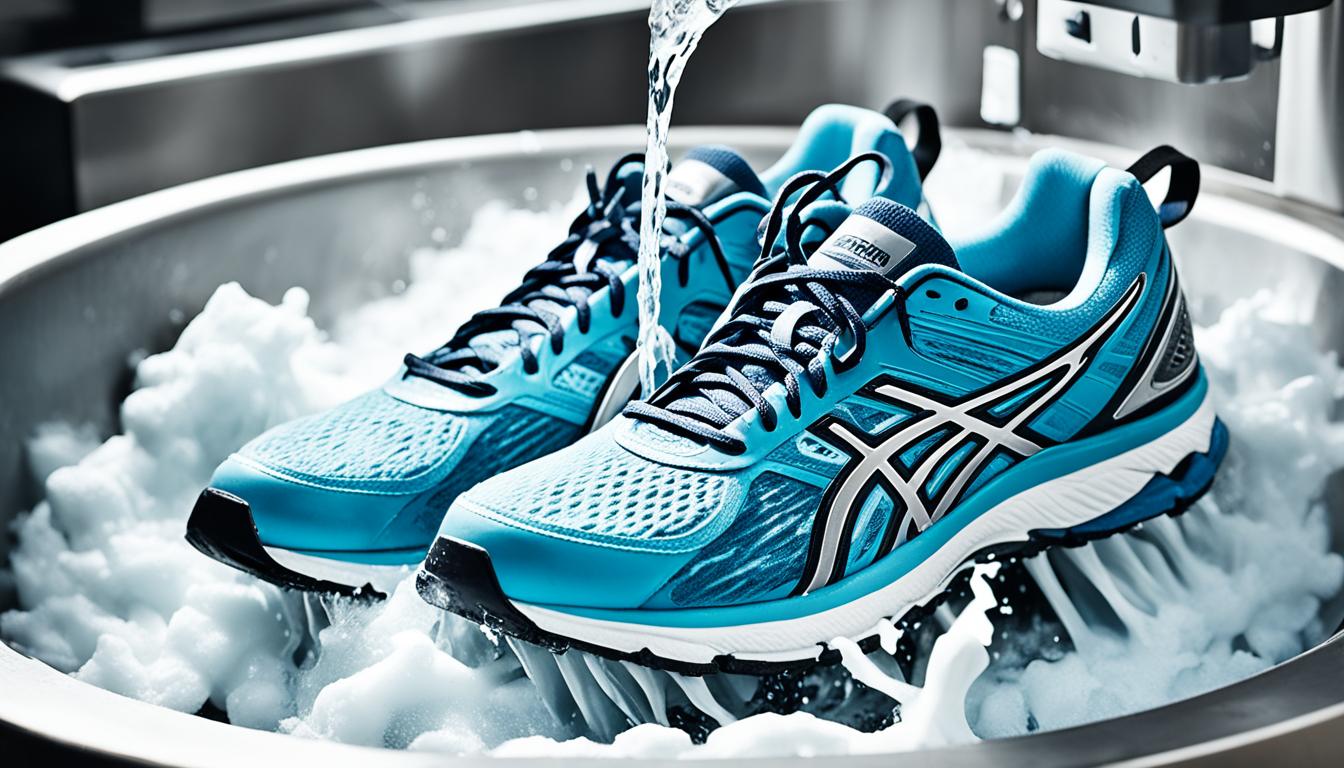Did you know a typical pair of running shoes can last 400 to 500 miles? But, they often encounter mud, puddles, and bad weather. This reveals a truth: knowing how to wash running shoes is crucial. Follow our detailed shoe washing guide. You’ll keep your shoes fresh-smelling with each step.
Key Takeaways
- Understanding the correlation between properly washed running shoes and their performance is key.
- Regular maintenance of athletic footwear extends its lifespan and maintains a fresh-smelling appeal.
- A step-by-step approach to washing shoes can revitalize even the most well-worn pairs.
- Selecting the right detergents or soaps is crucial to prevent damage to your sneakers.
- Discovering the pros and cons of hand-washing versus machine-washing ensures optimal care for various shoe materials.
Knowing shoe cleaning tips and having the right skills can keep your shoes ready. They’ll be in great shape for any adventure, whether on a track, trail, or city exploration.
Understanding the Importance of Clean Running Shoes
Keeping your running shoes clean is not just about staying neat. It’s key for your performance and your shoes’ life. Clean gear means top condition, making every run better.
Impact of Dirty Shoes on Performance
Not cleaning your sneakers can hurt your run. Dirt makes them heavy and less grippy. It also makes them less flexible. So, learning to clean them well is essential for good performance.
Extended Shoe Life Through Regular Maintenance
Cleaning your shoes does more than remove bad smells and stains. It fights material breakdown from sweat and bacteria. This keeps your shoes going strong for longer.
Here’s an easy weekly plan to keep your shoes in great shape:
| Day | Maintenance Activity | Benefit |
|---|---|---|
| Monday | Air out shoes | Reduces moisture and odor |
| Wednesday | Brush off dirt and dust | Prevents buildup and fabric damage |
| Friday | Spot clean stains | Maintains appearance and material integrity |
| Sunday | Deep cleaning session | Restores shoe functionality and comfort |
Following this simple cleaning schedule keeps your shoes ready for any run.
Pre-Cleaning Preparations: What You Need
Getting your shoes clean starts with having the right tools. Before you even turn on the tap, make sure you have everything you need for washing running shoes. Here’s what you’ll need for a deep clean and to check if it’s time for new shoes:
- Dish soap or a mild laundry detergent for a gentle yet effective cleanse.
- Water, preferably at room temperature, to mix with the cleaning agent.
- Vinegar, which serves as a natural deodorizer and cleaner for tough stains and odors.
- A soft bristle brush or an old toothbrush to scrub away dirt without damaging shoe fabric.
- A sink or large bowl to contain water and suds as your cleaning workstation.
First, take a good look at your running shoes. Look for big problems like torn fabric or soles coming off. If they’re still good, you’re ready to make them look like new again.
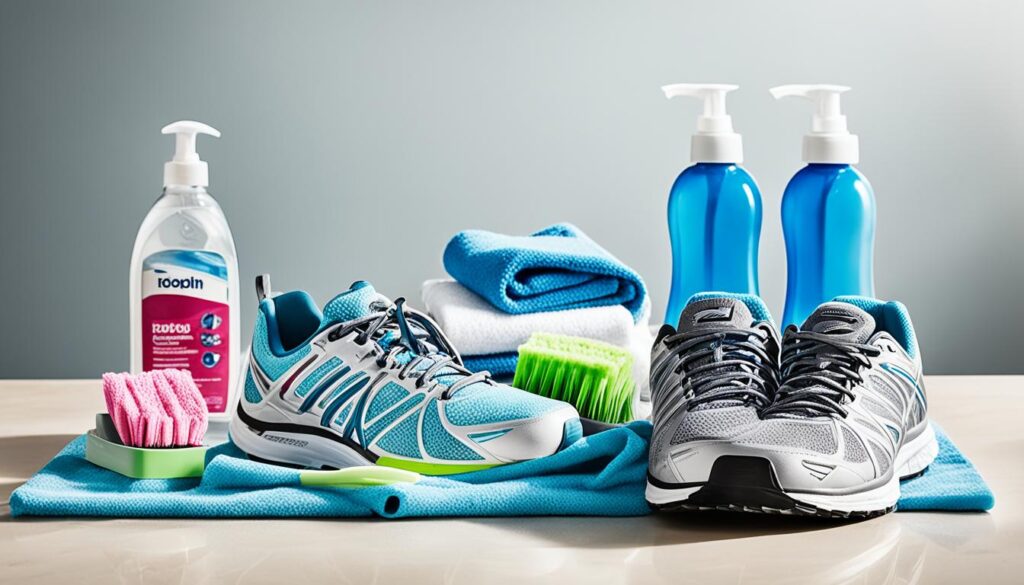
Get your cleaning spot ready by making sure the sink or bowl is clean. Keep a towel handy for drying or any spills. With everything set, shoe care will be easy and effective.
| Item | Purpose | Notes |
|---|---|---|
| Dish Soap/Laundry Detergent | Cleaning Agent | Mild and suitable for fabrics |
| Water | Base for Solution | Room temperature |
| Vinegar | Deodorizer/Stain Remover | Especially helpful for insoles |
| Soft Bristle Brush/Toothbrush | Scrubbing Tool | Soft to protect shoe material |
| Sink/Bowl | Cleaning Station | Ensure it’s clean before use |
With the right items and tips, you’re almost ready to get your running shoes looking great again. Let’s keep them functioning well and looking sharp.
How to Wash Running Shoes: Step-By-Step Guidance
Caring for your sneakers properly means they’ll last longer and stay fresh. It’s vital for athletes and shoe lovers to learn how to clean their running shoes the right way. Doing so improves the shoes’ performance and keeps them hygienic.
Brush Off Excess Dirt for a Better Clean
Start by removing dirt from your shoes. Use a soft brush to clean the outsole and upper parts. This step makes washing them later more effective and helps get rid of odors.
Creating the Optimal Cleaning Solution
Next, take out the laces and insoles before cleaning. Mix water and a mild detergent to make a cleaning solution. Soaking your shoes in this mix helps loosen dirt without damaging them.
Tackling Tough Insole Odors
Keeping insoles fresh is crucial because they can get smelly from sweat and bacteria. Here are some ways to combat those tough odors:
| Insole Treatment | Description | Benefits |
|---|---|---|
| Machine Wash | Place insoles in a pillowcase and wash on a gentle cycle with mild detergent. | Effective in bulk odor removal and convenience |
| Hand-Wash with Vinegar Solution | Combine equal parts vinegar and water to clean the insoles by hand. | Targets deep-set odors and doesn’t subject insoles to machine washing |
| Baking Soda | Lightly dust insoles with baking soda and let stand overnight before brushing off. | Absorbs odor without water, useful for quick touch-ups |
| Charcoal Inserts | Insert charcoal-based odor eliminators into shoes post-wash. | Long-term odor control and moisture absorption |
Carefully clean every part of your shoe and rinse them well. Make sure they dry properly to prevent mold or mildew. Following these steps means your running shoes will be ready and comfy for your next outing.
Best Detergents and Soaps for Your Sneakers
Choosing the right soap or detergent is crucial for keeping sneakers looking new. Not every cleaner is good for your athletic shoes. Some can actually harm them. A good shoe washing guide will tell you to pick something that cleans well but is still gentle.
A mild, gentle laundry detergent usually does the trick. Look for ones without dyes or perfumes if your shoes are delicate. Here’s a simple guide for picking the right soap or detergent:
- For daily washes, a mild detergent is best.
- Choose ‘delicate’ or ‘gentle’ soap for sensitive materials.
- Check the manufacturer’s shoe cleaning tips for knits or special finishes before choosing your cleaner.
Some sneaker fans prefer cleaners made just for athletic shoes. These special formulas keep sneakers in top shape. Just make sure to read the instructions and test it on a small spot first.
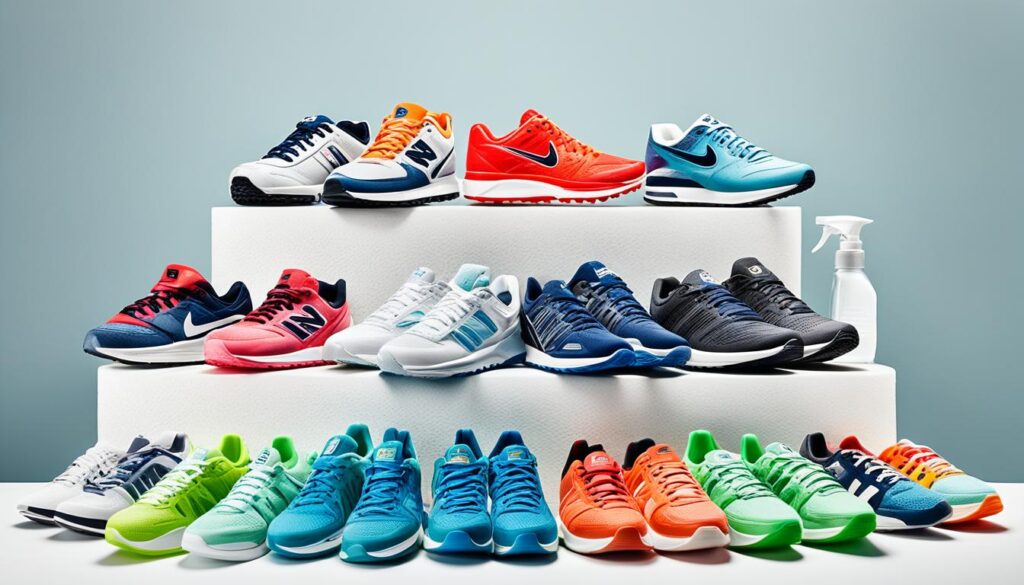
The secret to keeping sneakers clean lies in following shoe cleaning tips well. This includes picking the right cleaner and sticking to a good cleaning routine. Gentle and effective should be your cleaning motto.
Hand-Wash Vs. Machine-Wash: Pros and Cons
Deciding how to wash running shoes can be tricky. People often wonder whether to opt for hand-washing or machine-washing. Each method has its pros and cons, affecting your shoes’ quality and structure.
Hand-washing is seen as the safer option. It’s best for shoes with delicate materials or detailed designs. The machine might be too harsh. Yet, machine-washing has its appeal, particularly for durable materials like cotton, nylon, and polyester. This is only if you follow the care labels closely.
| Method | Pros | Cons |
|---|---|---|
| Hand-Wash |
|
|
| Machine-Wash |
|
|
Choosing how to wash your shoes depends on a few things. Consider the material, your available time, and the shoe’s care instructions. Hand-washing helps shoes last longer. But, machine-washing can work for some shoes, if done right.
Shoe Washing and Material Care
Taking care of your athletic shoes properly makes them last longer and perform better. It’s important to know that different materials need different cleaning methods. Here, we’ll share tips on how to wash your athletic shoes and how to keep them safe during cleaning.
Handling Different Types of Running Shoe Materials
Leather sneakers need to be cleaned with a dry brush and gentle cleaner to avoid damage. For suede, a brush or special eraser can remove marks. Knit shoes are popular for their look and should be cleaned along the fabric’s grain.
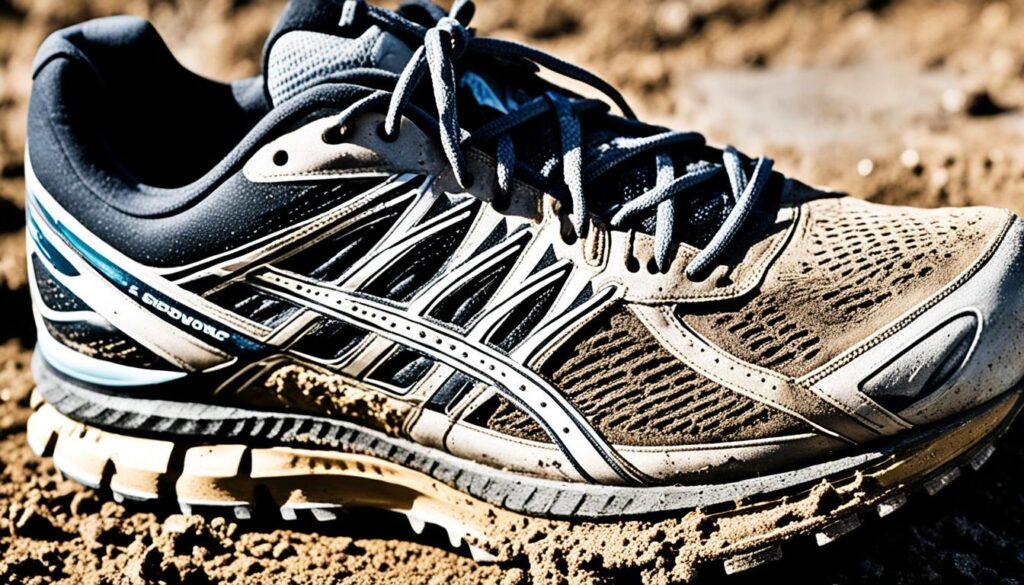
Safeguarding Shoes During the Cleaning Process
Using cleaning erasers and conditioners can protect your shoes when you clean them. Shoes can last longer with these tools, just like delicate fabrics. Knowing how and when to use these products is key to taking care of your sneakers.
| Material | Cleaning Tool | Cleaning Agent | Protective Measures |
|---|---|---|---|
| Leather | Dry Brush | Mild Cleaning Solution | Leather Conditioner |
| Suede | Suede Brush/Eraser | N/A | Waterproofing Spray |
| Knit | Soft Cloth | Mild Detergent | None (Avoid Excess Moisture) |
| Mesh | Soft-Bristled Brush | Antibacterial Soap | Quick Dry Techniques |
Following these care tips will make your sneakers last longer. Good care is important whether you’re running a race or just enjoy jogging. With the right maintenance, your shoes will support your active life.
Drying Techniques for Fresh-Smelling Shoes
Getting your shoes to dry right is key to keeping them smelling fresh and removing bad odors. Using the correct drying method is important. It helps keep your sneakers in good shape and ready for anything. Let’s explore how to dry your shoes well without harming their build or leaving any bad smells.
Effective Air Drying Strategies
Air drying is best for taking care of sneakers. It lowers the chance of damage from too much heat. This gentle method keeps the shoe’s fabric in good condition. It helps keep their original shape and quality. Here’s how to air dry your shoes the right way:
- Place them somewhere dry with good air flow.
- Use paper towels inside the shoes to keep their shape and dry faster.
- Let them sit overnight or in front of a fan to speed up drying.
- Stay away from direct sunlight to prevent fading and material damage.
Why Heat Drying Can Be Harmful to Your Shoes
Using heat to dry shoes quickly might seem like a good idea, but it can actually hurt them. Heat drying or using regular dryers can cause problems like:
| Heat Drying Effect | Potential Negative Outcome |
|---|---|
| Material Shrinkage | They lose shape, become uncomfortable, and don’t fit right. |
| Adhesive Damage | The soles might come off or get weaker, damaging the shoe. |
| Material Warping | It can alter how shoes look and perform. |
| Discoloration | Shoes can fade unevenly or get stained, making them look old. |
It’s best to avoid using heat to dry your shoes. Stick with air drying at room temperature. This method keeps your shoes lasting longer and smelling better.
Shoe Cleaning Tips for Removing Stubborn Stains
When you find tough stains on your favorite sneakers, don’t worry! The right cleaning tips can make your running shoes look new again. Pre-treatment is key for successful shoe washing, particularly with stubborn marks. Using a gentle stain remover for your shoe’s fabric, plus a soft brush or cloth, is crucial.
Here’s a quick guide on handling common stains:
| Stain Type | Pre-Treatment Solution | Application Tips |
|---|---|---|
| Mud and Grime | Mild detergent mixed with water | Gently scrub in a circular motion after letting it soak for 15 minutes. |
| Grass | Isopropyl alcohol or dedicated sports cleaner | Apply directly to the stain and dab, avoid rubbing to not spread the stain. |
| Blood | Cold water and enzymatic cleaner | Treat the stain as soon as possible for better chances of complete removal. |
| Oil or Grease | Baking soda and a drop of dish soap | Let sit on the stain for an hour before brushing off the residue. |
The material of your running shoes determines how you remove stains. For example, delicate mesh or knit fabrics need gentle care. Always check your shoe’s label for maintenance advice and follow the manufacturer’s guidelines for the best outcome.
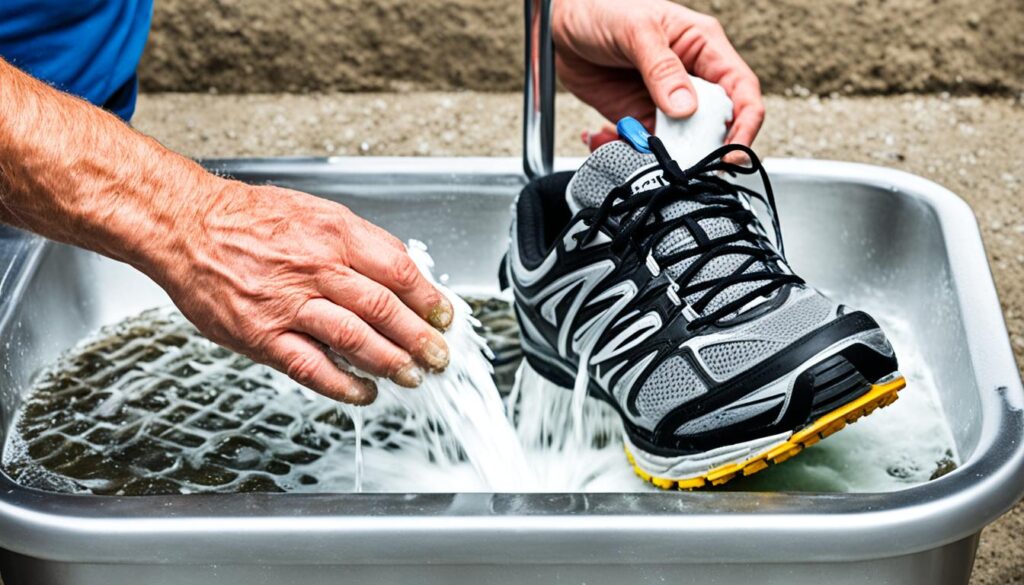
- Always test the cleaning solution on a small, inconspicuous area first.
- Rinse thoroughly after stain treatment to remove any soap residue.
- For heavy stains, repeat the treatment process until satisfactory results are achieved.
Follow these tips to get rid of stubborn stains on your sneakers. Patience and the right technique will help keep your running shoes looking their best.
Sneakers Maintenance: Keeping Your Shoes in Peak Condition
For those who see their footwear as more than just shoes, knowing the best way to clean running shoes is key. Adding smart habits to your daily life can greatly improve how your clean sneakers feel and last.
Keeping a regular washing athletic shoes routine means your sneakers will always be ready for action. This is crucial not only for their look but for maintaining the tech inside them. This tech helps your shoes perform at their best and keeps you comfortable.
Remember, maintenance is always simpler than a complete overhaul. Treat your sneakers to regular care, and they will serve you well for countless miles.
- Inspect shoes regularly for signs of wear and damage.
- Post-run, remove excess dirt and let shoes air out.
- Periodically deep clean based on usage and exposure to dirt.
- Store in a cool, dry place away from direct sunlight.
When cleaning your sneakers, picking the right tools is crucial. Each material needs a different method:
| Material | Brush Type | Cleaning Agent | Special Considerations |
|---|---|---|---|
| Mesh | Soft bristle brush | Mild detergent | Gentle, circular cleaning movements |
| Leather | Dry brush | Leather cleaner | Condition after drying |
| Suede | Suede brush or eraser | Suede cleaner | Avoid water, use cleaning block for stains |
| Knit | Soft cloth | Gentle soap solution | Clean according to grain, very minimal water |
Shoe maintenance isn’t just about cleaning. It’s also about how you use and care for them every day. By putting in a little effort, you can keep your clean sneakers in great shape. This not only extends their life but also improves your performance.
Conclusion
Keeping your running shoes clean is more than just for looks. It helps them last longer and work better for you. Learning how to wash running shoes means you are taking care of what helps you perform. This guide showed you how to do it and gave important shoe cleaning tips to make you a pro.
Just like you stick to your runs, stick to cleaning your shoes regularly. Doing this keeps them working as they should and lasts longer. With this shoe washing guide, you know how to keep your shoes feeling and smelling fresh.
As you keep breaking your own records, remember that clean shoes help you succeed. They give you the confidence to face any challenge ahead. Take care of them, and they’ll take care of you on your runs.

